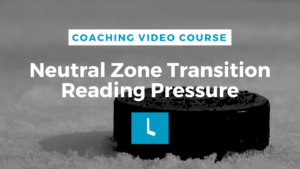(Transcribed from How to Play Hockey: Our Minor Hockey Coaching Course.)
Be fashionably late to the party, but be careful. If you are too early, or too late, the game will pass you by and no one will even notice you were there. As good as those plays look on the whiteboard when you draw them up or when you watch a highlight reel, they all rely on one concept…TIMING. Here we look at what it means and how it helps all over the ice.
Definition:
A concept of spatial awareness that is absolutely critical in hockey. The best players have a sense of time and space. They know when to go a hundred miles per hour and they know when to slow it down so that they can support their teammates properly.
[maxbutton id=”2″ ]
One example where I see poor timing more often than anywhere else is on a break out in the defensive zone.
What not to do:
- D1 has gone D to D with D2.
- D2 moves the puck up ice to his strong side W. This W is now trying to make a quick play to the C, but the C has jumped to early and is not flat enough.
- Now the C has not timed it properly or come under/behind the puck with patience. He/she has gone to far ahead. Now he/she is in no mans land just waiting for the puck. Completely out of position. Usually outside of the zone.
What to do:
- The C sees the puck go D to D between D1 and D2.
- The C comes across slowly with patience, under/behind the puck supporting D1 and D2 as well as the play that is developing. Remember to always be an option.
- Now you see that D2 is going to make a quick up play to the strong side W.
- This W begins to get his/her feet up ice as the pass is being made. Always remembering to shoulder check to be aware of the opposing defenders positioning.
- Now the C is able to jump with speed to the open area, allowing the strong side W to make either an easy direct pass, or if being pressured, a simple chip to an area off the wall.
Remember that if you rush to get involved in a play to early, you will end up to far ahead. Which turns into a good chance that you will turn the puck over to the opposing team.
Being to excited thinking, “I want to help” but without any sense of patience with timing for the development of the play will get you in trouble. You will be to far ahead and no help.
So it’s a lot about being patient, having patience, then being ready to come not at one speed of 100 miles per hour. Great players know when to go slow or when to jump and you are a lot harder to predict. This is a hard thing to teach but we often find players who play a lot of different sports develop a better understanding and athletic sense of how to get open, when to jump into holes and when to hold back.
Looking to download half ice hockey practice plans, goalie drills for teams (not a goalie coach?!) or small area games drills? We’ve got you covered too. Click here. Perfect for recreational level coaches.





